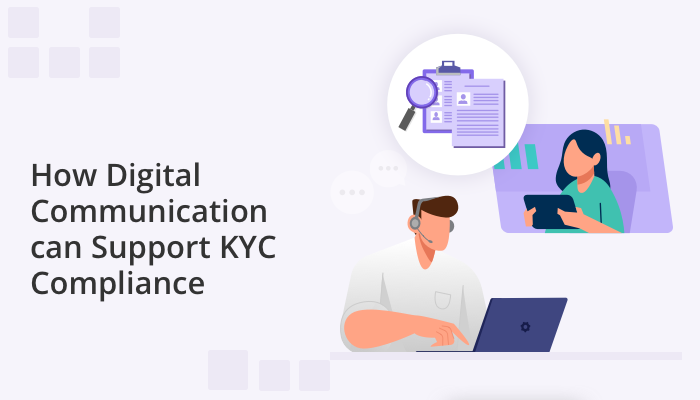
This article has been updated since it was first published in 2020
The digital age has revolutionized the way businesses communicate with their customers. Digital communication has made it easier for companies to stay in touch with customers, provide timely updates, and offer personalized services. It has also enabled businesses to meet their Know Your Customer (KYC) compliance requirements more efficiently. In this blog, we will explore how digital communication can support KYC compliance and how businesses can take advantage of this technology to ensure compliance with KYC regulations.
What Is KYC?
KYC stands for “Know Your Customer” and is a process used by organizations to verify the identity of their customers. It involves collecting and verifying personal information such as name, address, date of birth, and other relevant documents, such as a passport or driver’s license. The purpose of KYC is to prevent financial fraud and money laundering.
KYC regulations are enforced by most countries around the world. This includes countries such as the United States, Canada, the United Kingdom, Australia, Japan, Singapore, and many more.
While KYC has been used in multiple industries, it is primarily applied in the banking and finance industry. For example, it is mandated by the Reserve Bank of India (RBI) as customer compliance for banks.
What is Digital KYC?
The digitization of KYC has transformed the way the verification process takes place. Digital KYC is an online process that enables organizations to verify the identity of their customers through digital means. It is no longer necessary for customers to enter a bank branch in person to open an account. Now, an array of digital tools and platforms enable customers to complete the identity verification process remotely, including real-time video KYC.
How Digital Communication Can Support KYC
Digital communication offers a range of useful technologies like real-time video KYC, machine-learning verification of documents, electronic signatures, biometric authentication and more. Significantly, digital communication can support KYC compliance in several ways.
First, digital communication can provide a secure and efficient way to collect and store customer information. By using online methods such as email, text messaging, and online forms, businesses can easily collect and store customer information in a secure and compliant manner.
Second, digital communication can help businesses monitor customer activity and transactions in real-time, allowing them to quickly identify any suspicious activity that may be indicative of money laundering or other financial crimes.
Third, digital communication can help businesses keep customer data up-to-date. By using automated digital communication tools, businesses can easily send out reminders to customers to update their information or to provide additional documentation to meet KYC requirements.
Finally, digital communication is extremely helpful with facilitating the identity verification process. The ability to chat, send documents, and do a video call within a single app, helps agents to complete a remote verification process in real-time.
By using secure digital communication tools, businesses can easily stay up-to-date with the latest KYC regulations and ensure that their customer data is compliant with those regulations.
What Are the Benefits of Video KYC?
KYC through video calls is a particularly useful tool because it enables customer information and documents to be verified in real-time through a video. Video KYC is a process in which customers can complete identity verification and onboarding remotely via video call. The process is conducted by an agent who interacts with the customer via video link and collects the necessary identification documents and information. The customer’s identity is then verified by comparing the photo or video taken during the call with the identity documents provided. Video KYC is becoming increasingly popular, as it provides a more convenient and secure alternative to in-person KYC processes.
Video KYC offers multiple advantages to the digital KYC process, not least of which is that it promotes speed and convenience. Let’s look at some of the advantages in more detail.
- Increased security: Video KYC helps to reduce fraud and identity theft by verifying the customer’s identity in real-time. It also helps to reduce the chances of money laundering and other financial crimes.
- Improved customer experience: Video KYC offers a more convenient and efficient customer experience compared to traditional KYC methods. It eliminates the need for customers to physically present themselves at a branch or office for verification. While form filling is never a pleasant experience, the ability to engage with customers face-to-face in real-time via a video conference personalizes an otherwise impersonal experience and creates a positive first impression with new customers.
- Cost savings: Video KYC eliminates the need for physical infrastructure and reduces the cost of customer onboarding. It also reduces the cost of manual labor associated with manual KYC processes.
- Greater Accessibility: It allows easier access to financial services for users in remote areas, or who are mobility impaired, enabling them to connect with bank personnel and open bank accounts digitally.
- Faster onboarding: Video KYC enables organizations to onboard customers quickly and efficiently. This helps to reduce customer acquisition time and increase customer satisfaction.
- Improved compliance: Video KYC helps organizations to comply with KYC regulations and anti-money laundering laws. It also helps to reduce the risk of non-compliance with regulatory requirements.
How Does Video KYC Work?
How the video KYC process works differ between banks and organizations – it may be done through a browser or a video calling app.
On a browser, the KYC page will require the user to register and create an account. Likely they will be asked to provide an OTP (One Time Password). After that, they will be taken to a video KYC page where the process begins.
Video KYC apps have become a convenient tool for digital verification on different devices. These video apps for KYC have various features that make the process smoother. With in-app messaging, information and clarifications can be conveyed digitally and instantly. File-sharing features allow users to share document files during the call to confirm their identities. Facial identification through liveness detection helps ensure the authentication of the user. These multi-feature apps allow for multiple channels of customer engagement while on a real-time video call meeting.
Using QuickBlox Video SDK to support your KYC Compliance needs
Digital communication tools offer several features to support KYC compliance. In particular, video calling apps allow the KYC compliance process to take place in one session over a real-time video KYC call, making the process convenient and seamless.
Instant communication tools like in-app messaging and file sharing make it quicker, allowing documents and personal details to be integrated with the video call. With multiple levels of verification, these apps offer viable support for KYC compliance.
QuickBlox’s video calling application solutions for KYC can be integrated into web and banking applications. The application features include live chat, secure messaging, and instant file sharing. Our real-time communication solutions offer immediate support to enable a smooth verification process. Contact us to find out more.






